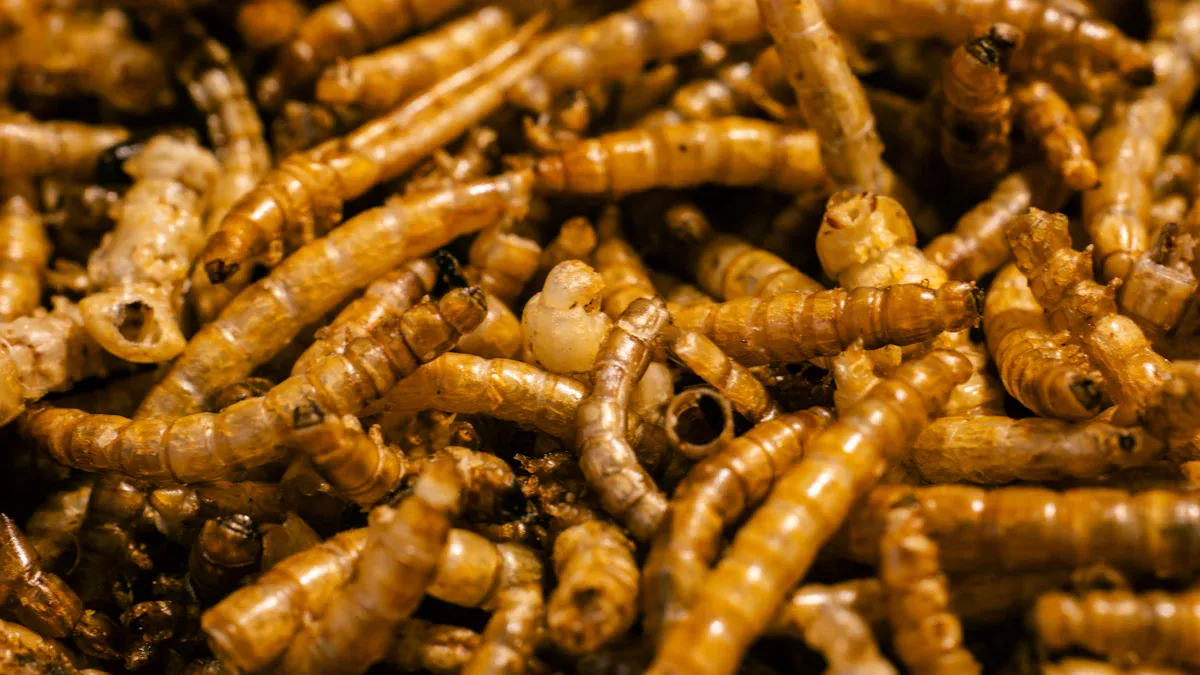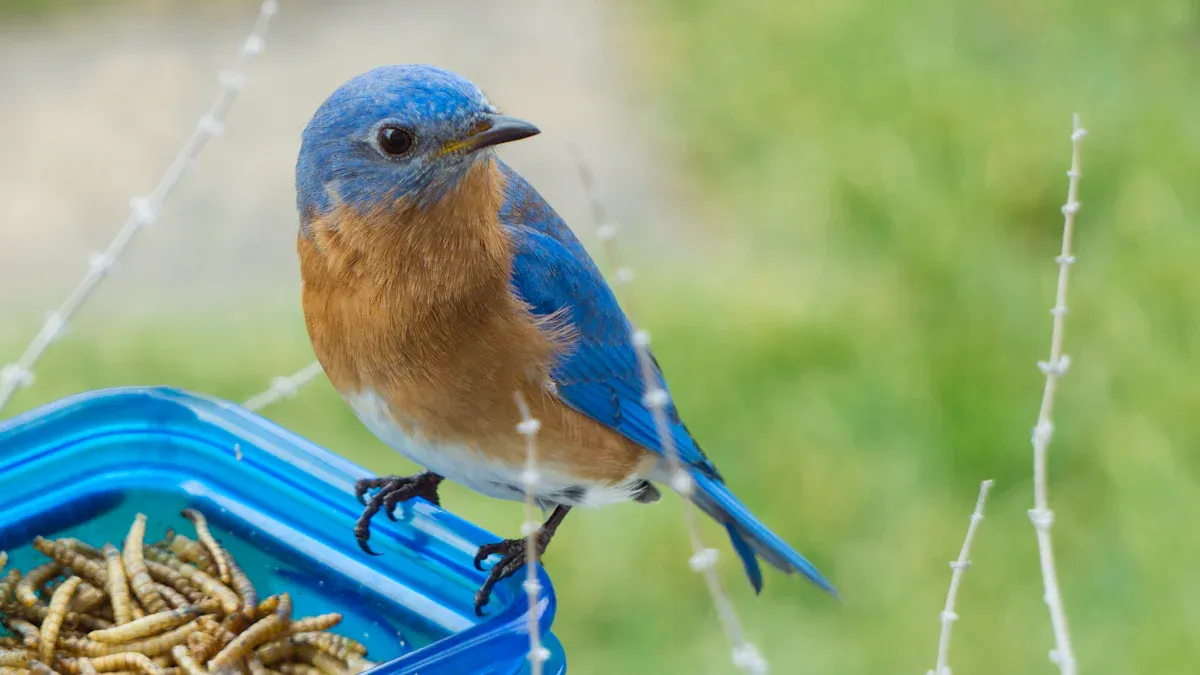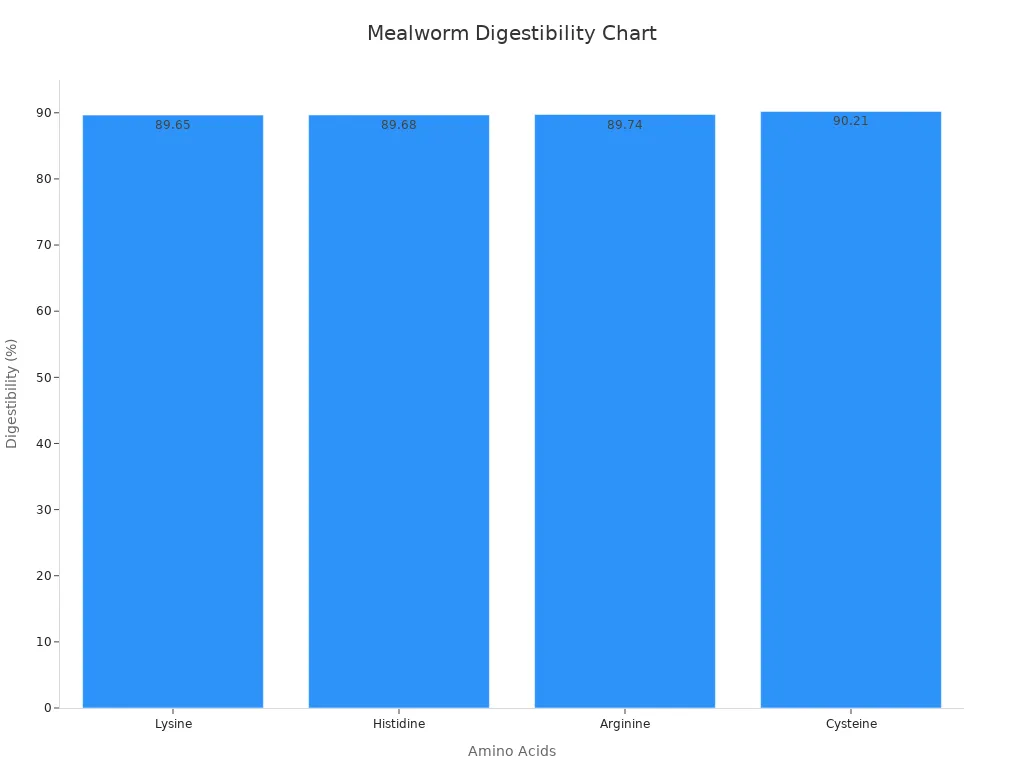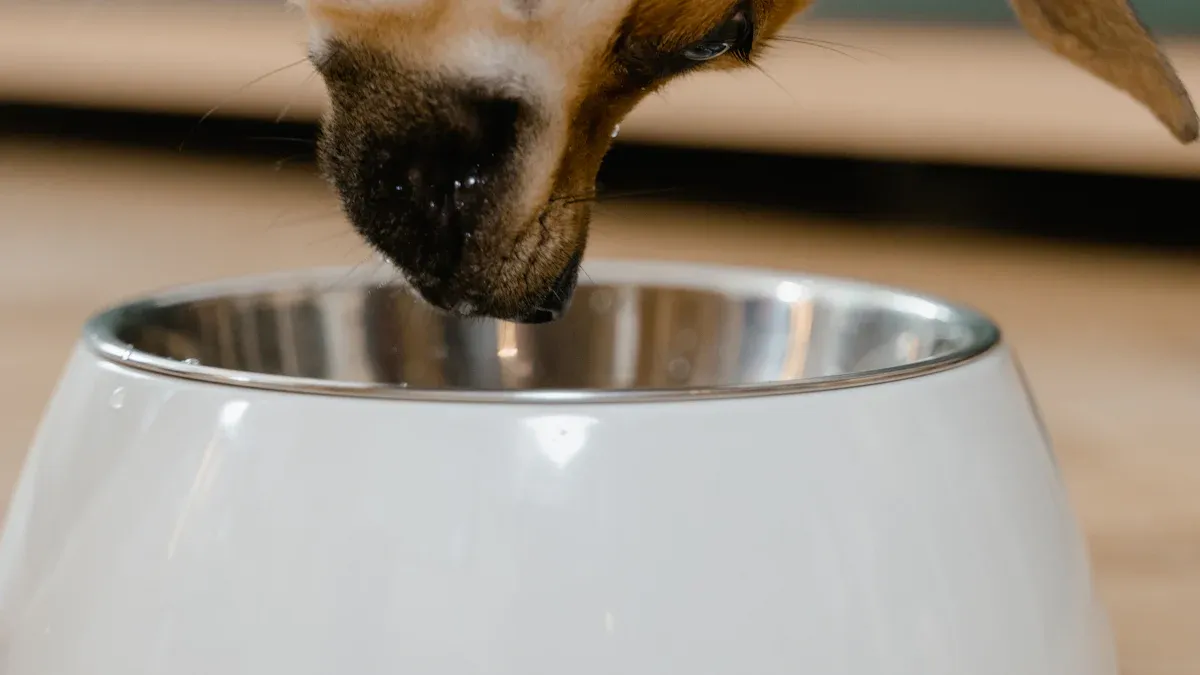
Dried mealworms stand out as a safe, nutritious option for pets. Studies show real benefits. For example:
| Benefit | Improvement | Significance |
|---|---|---|
| Body Weight | Increased | p < 0.01 |
| Protein Digestibility | Improved | p = 0.05 |
| Growth Biomarkers | Enhanced | p = 0.03 |
The Nutritional Value of Dried Mealworms supports healthy growth and energy for pets.
Key Takeaways
- Dried mealworms provide high-quality protein, healthy fats, and essential amino acids that support pet growth, energy, and overall health.
- Mealworms are safe and easy to digest for most pets when introduced gradually, with low allergy risks and strict safety standards.
- Mealworm farming uses fewer resources and produces less greenhouse gas than traditional livestock, making it a sustainable choice for pet food.
Nutritional Value of Dried Mealworms

Dried mealworms have become a popular ingredient in pet food because of their impressive nutrition. People often ask what makes them so special. The answer lies in the Nutritional Value of Dried Mealworms, which covers protein, healthy fats, essential amino acids, and a range of vitamins and minerals.
Protein Content and Quality
Protein is one of the most important nutrients for pets. The Nutritional Value of Dried Mealworms stands out because they offer a high protein content that rivals or even beats traditional sources like poultry and beef. Take a look at this table:
| Statistic | Protein Content (%) (Wet Weight Basis) |
|---|---|
| Mean | ~18.7 – 18.8 |
| Minimum | 16.1 – 16.3 |
| Maximum | 23.2 – 23.6 |
On a dry matter basis, the protein content can range from 25% to 75%. That’s a huge range and shows why so many pet owners and manufacturers trust the Nutritional Value of Dried Mealworms. Even though chitin in mealworms can affect how protein is measured, advanced methods like near-infrared reflectance spectroscopy help get accurate results. Studies show that mealworm protein levels match or even exceed those found in chicken or beef. This makes dried mealworms a strong choice for pets that need plenty of protein for growth and energy.
Healthy Fats and Fatty Acids
Fats are not just about calories. They help pets absorb vitamins and keep their skin and fur healthy. The Nutritional Value of Dried Mealworms includes a rich profile of healthy fats, especially unsaturated fatty acids. Oleic acid is the most abundant, making up 30% to 60% of the total fat. Palmitic acid and linoleic acid also appear in high amounts. Here’s a quick look at the main fatty acids:
| Fatty Acid | General Abundance in Mealworms |
|---|---|
| Oleic acid (C18:1) | 30–60% (most abundant) |
| Palmitic acid (C16:0) | High |
| Linoleic acid (C18:2) | High |
| Myristic acid (C14:0) | Present |
| Stearic acid (C18:0) | Present |
| Pentadecanoic acid (C15:0) | Present |
| Palmitoleic acid (C16:1) | Present |
| Linolenic acid (C18:3) | Present |
The fatty acid profile can change based on what the mealworms eat, but they always provide a good mix of saturated and unsaturated fats. Compared to many traditional pet food ingredients, dried mealworms offer more unsaturated fats, which are better for heart health and energy.
Essential Amino Acids
Pets need essential amino acids for muscle growth, immune support, and overall health. The Nutritional Value of Dried Mealworms shines here, too. Research shows that dried mealworms contain high levels of important amino acids like lysine, methionine, threonine, tryptophan, tyrosine, isoleucine, leucine, and valine. For example, when mealworm powder is added to food, lysine levels can more than double. Tyrosine and valine can increase by over 90%. These amino acids are vital for pets, especially growing animals or those recovering from illness.
Studies also show that the protein in dried mealworms is easy for pets to digest. In tests with growing pigs, mealworm protein had high digestibility, similar to or better than other animal protein sources. This means pets can use the nutrients in mealworms efficiently.
Vitamins, Minerals, and Dietary Fiber
The Nutritional Value of Dried Mealworms goes beyond protein and fat. They also provide a range of vitamins and minerals that support pet health. Nutritional analysis shows that dried mealworms contain:
- Vitamins: A, D3, E, B12, biotin, riboflavin, thiamine, pyridoxine, folic acid, pantothenic acid, niacin, and K3.
- Minerals: Phosphorus, calcium, sodium, potassium, magnesium, zinc, copper, iron, manganese, iodine, cobalt, and selenium.
Dried mealworms also contain dietary fiber, mainly in the form of chitin. While chitin is not digested like other fibers, it can help support gut health in some pets. The combination of vitamins, minerals, and fiber makes the Nutritional Value of Dried Mealworms complete and balanced for many animals.
Tip: Dried mealworms are not just for exotic pets. Many garden birds, like robins and bluebirds, love them too. Products like Bird Dried Mealworm Topping attract a wide variety of colorful birds and provide all the protein without the wriggle.
The Nutritional Value of Dried Mealworms makes them a smart choice for pet owners who want to give their animals the best nutrition possible.
Benefits for Different Types of Pets
Birds and Wildfowl
Dried mealworms attract many garden birds. Bluebirds, chickadees, cardinals, nuthatches, and robins all enjoy this protein-rich snack. Bird Dried Mealworm Topping makes feeding easy and mess-free. People often see more colorful birds in their yards when they offer mealworms. Robins, in particular, seem to love them. Many wildfowl also benefit from mealworms. They provide a healthier alternative to bread at local ponds.
Tip: Place dried mealworms in a feeder or sprinkle them on the ground to invite a variety of birds to your garden.
Reptiles and Amphibians
Mealworms offer reptiles and amphibians a valuable source of protein, fat, and minerals. Studies show that amphibians like toads grow well when they eat mealworms. These insects support energy, skin health, and immune function. However, reptiles and amphibians need vitamin A, so owners should dust mealworms with vitamin A powder or use gut-loading methods. Feeding dried mealworms once or twice a week as a treat helps keep their diet balanced.
Fish
Fish also benefit from dried mealworms. Research shows that fish eating mealworm-based diets grow just as well as those eating traditional fishmeal. Mealworms help maintain healthy protein and fat levels in fish. They also support the immune system and improve gut health. Fish like salmon, trout, and tilapia thrive on diets that include mealworms.
- Fish fed mealworms show strong growth.
- Their immune systems get a boost.
- Mealworms help keep water clean by producing stable waste.
Small Mammals
Small mammals such as hamsters, hedgehogs, and sugar gliders enjoy dried mealworms as a tasty treat. These insects provide extra protein and energy. Owners can use dried mealworms to encourage natural foraging behavior. Always offer mealworms in moderation to keep pets healthy and happy.
Comparison with Traditional Pet Food Ingredients
Animal-Based Proteins
Many pet foods use animal-based proteins like chicken, beef, lamb, or fish. These ingredients offer high-quality protein and essential amino acids. Studies show that mealworm protein quality, measured by DIAAS-like scores, matches top animal proteins such as salmon, lamb, and beef. Mealworm ingredients also have lower ash content and more unsaturated fatty acids. When researchers replaced fish meal or poultry by-products with dried mealworm protein in animal diets, they saw no negative effects on growth, nutrient digestibility, or health. Pets digested mealworm protein just as well as traditional animal proteins.
| Protein Source | Carbon Footprint (kg CO2-eq/kg) |
|---|---|
| Mealworm Protein70 | 3.10 |
| Lamb Ingredient | 5.51 |
| Chicken Meal (low quality) | <3.10 |
Plant-Based Proteins
Soybean meal and other plant-based proteins are common in pet food. These ingredients provide protein and fiber, but sometimes lack certain essential amino acids. Dried mealworms offer a protein quality that is equal to or better than soybean and fishmeal. Their amino acid profile meets most daily needs for pets, with threonine levels even higher than some plant sources. Mealworms also supply healthy fats, including omega-6 fatty acids, which support growth and disease prevention.
Unique Advantages of Mealworms
Mealworms bring something special to pet food. They deliver high-quality protein, healthy fats, and a balanced amino acid profile. Their unsaturated fat content supports heart health. Mealworms also help the environment. Their carbon footprint is much lower than beef or lamb. For example, wet mealworm ingredients produce only 0.90 kg CO2-eq per kg, compared to 12.21 for beef offal and 23.65 for lamb. Pet owners who choose mealworm-based products, like Bird Dried Mealworm Topping, support both their pets’ health and the planet.
Tip: Mealworms can be a tasty, eco-friendly upgrade for pets who need extra protein and nutrition.
Digestibility and Safety of Dried Mealworms
Scientific Findings on Digestibility
Dried mealworms are easy for pets to digest. Scientists have tested how well animals can use the protein and amino acids in mealworms. They use special feeding studies with birds and pigs to measure digestibility. The results show that most essential amino acids in mealworms have a digestibility rate above 90%. This means pets can get almost all the important nutrients from mealworms.
| Study / Model | Mealworm Species | Digestibility Measure | Digestibility Rate / Result |
|---|---|---|---|
| Precision-fed cecectomized rooster assay | Alphitobius diaperinus and Tenebrio molitor | Indispensable amino acid digestibility (AA digestibility) | >90% for most indispensable AA except histidine and valine |
| Growing pigs (Yoo et al., 2019) | Tenebrio molitor larvae | Apparent ileal digestibility (AID) of lysine, histidine, arginine | Lysine: 89.65%, Histidine: 89.68%, Arginine: 89.74% |
| Growing pigs (Yoo et al., 2019) | Tenebrio molitor larvae | Standardized ileal digestibility (SID) of cysteine | 90.21% |
| Early-weaned piglets (Ji et al., 2016) | Tenebrio molitor larvae | Apparent amino acid digestibility (AID) | High digestibility (>84% for indispensable AA) with no significant differences compared to control |

These studies prove that dried mealworms offer high-quality protein. Pets can absorb and use these nutrients well, which supports healthy growth and energy.
Allergenicity and Safety Standards
Safety is important when adding new foods to pet diets. Experts have studied dried mealworms to check for allergens and toxins. The European Food Safety Authority (EFSA) reviewed dried yellow mealworm as a novel food. Their tests looked for allergenic proteins and possible reactions. They found that mealworms could cause allergies in some pets, especially those sensitive to shellfish or dust mites. However, the overall risk stays low when mealworms are used as directed.
Researchers also used advanced tools to study mealworm proteins. They checked if these proteins matched known allergens. The results showed that dried mealworms are safe for most pets. Toxicology tests and stability checks found no safety concerns. Pet owners can feel confident when choosing products like Bird Dried Mealworm Topping, knowing that these treats meet high safety standards.
Note: Always introduce new foods slowly and watch for any unusual reactions in pets. Most pets enjoy dried mealworms without any problems.
Sustainability and Environmental Impact

Resource Efficiency of Mealworm Farming
Mealworm farming stands out for its resource efficiency. Farmers can produce more protein with fewer resources compared to traditional livestock. Mealworms need less land, water, and energy. They also grow quickly and reproduce at a high rate. For example, a female mealworm (T. molitor) can lay about 160 eggs in just three months.
Here’s a table that shows how mealworm farming compares to other protein sources:
| Indicator | Mealworms | Milk | Chicken | Pork | Beef |
|---|---|---|---|---|---|
| Global Warming Potential | Low | 1.77–2.80× higher | 1.32–2.67× higher | 1.51–3.87× higher | 5.52–12.51× higher |
| Land Use | Very low | 1.81–3.23× higher | 2.30–2.85× higher | 2.57–3.49× higher | 7.89–14.12× higher |
| Methane Emissions | None | Yes | Yes | Yes | Yes |
A life cycle study in Austria found that producing 1 kg of edible mealworm protein uses less land and energy than raising chickens or cows. The study also showed mealworm farming has 18–72% lower impacts in most environmental categories.
Reducing the Carbon Pawprint
Mealworm production helps lower the carbon pawprint of pet food. Mealworms do not produce methane, a powerful greenhouse gas. Their cold-blooded bodies use less energy, so they release less carbon dioxide. Some farms use food waste to feed mealworms, which cuts down on emissions from waste management.
Ÿnsect, a large mealworm producer, found that mealworm protein uses 98 times less land per kilogram than livestock. In Canada, studies show that using food waste as mealworm feed can even make the process carbon negative.
Choosing products like Bird Dried Mealworm Topping supports a cleaner planet and helps reduce the environmental impact of pet care.
Practical Tips for Incorporating Dried Mealworms
Feeding Guidelines and Portion Sizes
Pet owners often wonder how much dried mealworm to give. Moderation is key. Mealworms work best as treats, not as a replacement for a balanced diet. Giving too many can lead to too many calories or an unbalanced meal. Here are some helpful tips:
- Start with a small amount and watch for any digestive upset or allergic reaction.
- Increase the portion slowly if the pet tolerates mealworms well.
- Each pet is different. Age, size, and health all matter. A veterinarian can help set the right portion size.
- Use mealworms to supplement regular food, not replace it.
- Calorie calculators can help guide treat portions, but always check with a professional for special needs.
Storage and Handling
Proper storage keeps dried mealworms fresh and nutritious. Moisture can cause spoilage, so always store mealworms in a cool, dry place. Sealed containers work best. Drying mealworms to reduce water activity below 0.60 helps stop bacteria and enzymes from breaking them down. Freeze drying keeps protein quality high, but it can increase fat oxidation. Vacuum or microwave drying methods balance nutrition and freshness. For short-term storage, refrigeration works for up to 10-12 days, but always check for spoilage before feeding.
Tip: Keep Bird Dried Mealworm Topping in an airtight container to lock in freshness and flavor.
Transitioning Pets to Mealworm-Enhanced Diets
Switching to mealworm treats should happen slowly. Start by mixing a few dried mealworms with the pet’s usual food. Watch for any changes in appetite or digestion. Gradually increase the amount over a week or two. This gentle approach helps pets adjust and lets owners spot any issues early. If a pet shows signs of discomfort, reduce the amount or pause the transition. Always keep regular food as the main part of the diet for balance and health.
Dried mealworms offer pets a nutritious, safe, and eco-friendly food choice. Many pet owners see benefits like:
- High protein and fat for balanced nutrition
- Sustainable farming practices
- Options for different pet diets
Mealworms fit into treats, kibble, or wet food. They help pets thrive while supporting the planet.
Article author: Felix
FAQ
Are dried mealworms safe for all pets?
Most pets can eat dried mealworms safely. Owners should introduce them slowly and watch for allergies. Always check with a vet for special dietary needs.
How should owners store Bird Dried Mealworm Topping?
Keep Bird Dried Mealworm Topping in a cool, dry place. Use an airtight container. This helps keep the mealworms fresh and tasty for pets.
Can dried mealworms replace regular pet food?
Dried mealworms work best as a treat or supplement. They do not replace a balanced diet. Pets need a variety of foods for complete nutrition.


